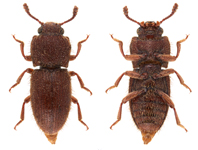Abstract
The genus Physalaemus Fitzinger is composed by 49 species (Frost 2020), which are grouped in two major clades (Lourenço et al. 2015), the Physalaemus cuvieri and P. signifer clades. Within the P. cuvieri clade, five species groups are recognized: P. biligonigerus, P. cuvieri, P. gracilis, P. henselii, and P. olfersii (Lourenço et al. 2015). According to Lourenço et al. (2015), seven species are assigned to the P. olfersii group: P. feioi, P. insperatus, P. lateristriga, P. maximus, P. olfersii, P. orophilus, and P. soaresi. Regarding their larval stage, four species have their tadpoles described for external morphology: P. maximus, P. olfersii, P. orophilus, and P. soaresi (Weber et al. 2005; Baêta et al. 2007; Giaretta et al. 2009; Pezzuti et al. 2019); two of them have their tadpoles described for oral internal morphology: P. maximus and P. soaresi (Ruggeri & Weber 2012). Herein, we describe the external and oral internal morphology of tadpole of P. lateristriga from Paraná State, southern Brazil, and compare them to the known tadpoles of the P. olfersii group.
References
Altig, R. (2007) A primer for the morphology of anuran tadpoles. Herpetological Conservation and Biology, 26, 180–207.
Altig, R. & McDiarmid, R.W. (1999) Body plan: development and morphology. In: McDiarmid, R.W. & Altig, R. (Eds.), Tadpoles: The Biology of Anuran Larvae. The University of Chicago Press, Chicago, Illinois, pp. 24–51.
Baêta, D., Lourenço, A.C.C., Pezzuti, T.L. & Pires, M.R.S. (2007) The tadpole, advertisement call, and geographic distribution of Physalaemus maximus Feio, Pombal, Caramaschi, 1999 (Amphibia, Anura, Leiuperidae). Arquivos do Museu Nacional, 65, 27–32.
Cassini, C.S., Cruz, C.A.G. & Caramaschi, U. (2010) Taxonomic review of Physalaemus olfersii (Lichtenstein & Martens, 1856) with revalidation of Physalaemus lateristriga (Steindachner, 1864) and description of two new related species (Anura: Leiuperidae). Zootaxa, 2491 (1), 1–33.
https://doi.org/10.11646/zootaxa.2491.1.1
Conte, C.E., Rossa-Feres, D.C., Nomura, F., Haddad, C.F.B. & D’Heursel, A. & (2007). The tadpole of Scinax catharinae (Anura: Hylidae) with description of the internal oral morphology, and a review of the tadpoles from Scinax catharinae group. Amphibia-Reptilia, 28, 177–192.
https://doi.org/10.1163/156853807780202387
Frost, D.R. (2020) Amphibian species of the world: an online reference, electronic database. Version 6.1. American Museum of Natural History, New York. Available from: http://research.amnh.org/herpetology/amphibia/index.html (accessed 15 December 2020)
Giaretta, A.A., Martins, L.B. & Santos, M.P. (2009) Further notes on the taxonomy of four species of Physalaemus (Anura, Leiuperidae) from the Atlantic Forest of Southeastern Brazil. Zootaxa, 2266 (1), 51–60.
https://doi.org/10.11646/zootaxa.2266.1.3
Gosner, K.L. (1960) A simplified table for staging anuran embryo and larvae with notes on identification. Herpetologica, 16, 183–190.
Lourenço, L.B., Targueta, C.P., Baldo, D., Nascimento, J., Garcia, P.C.A., Andrade, G.A., Haddad, C.F.B. & Recco-Pimentel, S.M. (2015) Phylogeny of frogs from the genus Physalaemus (Anura, Leptodactylidae) inferred from mitochondrial and nuclear gene sequences. Molecular Phylogenetics and Evolution, 92, 204–216.
https://doi.org/10.1016/j.ympev.2015.06.011
Mello, C.M., Gonçalves, D.S., Solé, M., Rossa-Feres, D.C. & Conte, C.E. (2018) A comparison of tadpoles of two populations of Leptodactylus plaumanni (Anura: Leptodactylidae), with a discussion of Leptodactylus tadpole morphology. Studies of Neotropical Fauna and Environment, 53, 233–244.
https://doi.org/10.1080/01650521.2018.1492661
Pezzuti, T.L., Leite, F.S.F., Silva, D.H., Lourenço, A.C.C. & Baeta, D. (2019) The tadpole of Physalaemus orophilus from the Atlantic rainforest of southeastern Brazil (Amphibia, Anura, Leptodactylidae). Zootaxa, 4629 (1), 141–145.
https://doi.org/10.11646/zootaxa.4629.1.11
Ruggeri, J. & Weber, L.N. (2012) A survey of the internal oral features and external morphology of Physalaemus larvae (Anura, Leptodactylidae). Zootaxa, 3200 (1), 1–26.
https://doi.org/10.11646/zootaxa.3200.1.1
Wassersug, R.J. (1976) Oral morphology of anuran larvae: terminology and general description. Occasional papers of the Museum of Natural History, 48, 1–23.
Weber, L.N., Carvalho e Silva, S.P. & Gonzaga, L.P. (2005) The tadpole of Physalaemus soaresi (Anura, Leptodactylidae), with comments on taxonomy, reproductive behavior, and vocalizations. Zootaxa, 1072 (1), 35–42.

